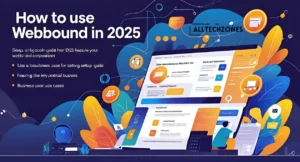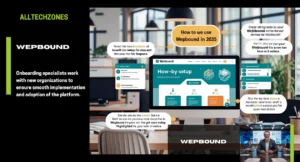In today’s digital landscape, businesses are constantly seeking innovative solutions to streamline their operations, enhance productivity, and maintain competitive advantages. Wepbound has emerged as a comprehensive platform that addresses these evolving needs through its robust suite of tools and integrated features. This detailed guide explores everything you need to know about Wepbound, from its core functionality to implementation strategies and optimization techniques for modern business environments.
Understanding Wepbound: Platform Overview
Wepbound represents a next-generation business platform designed to provide organizations with integrated solutions for project management, team collaboration, and operational efficiency. The platform combines multiple business functions into a unified interface, enabling companies to manage their workflows more effectively while reducing the complexity associated with managing multiple disparate systems.
The Wepbound platform serves businesses across various industries, from startups establishing their operational foundations to large enterprises seeking to optimize existing processes. Its cloud-based architecture ensures accessibility from anywhere while maintaining the security and reliability that modern businesses demand. The platform’s modular design allows organizations to customize their implementation based on specific requirements and growth objectives.
What sets Wepbound apart is its focus on user experience and seamless integration capabilities. The platform recognizes that businesses don’t operate in isolation and require tools that can connect with their existing technology ecosystem while providing room for future expansion and adaptation.
Core Wepbound Features and Capabilities
Project Management and Task Organization
The Wepbound platform excels in project management functionality, offering comprehensive tools for planning, tracking, and executing projects of various sizes and complexities. Users can create detailed project timelines, assign tasks to team members, set deadlines, and monitor progress through intuitive dashboards and reporting interfaces.
The task management system includes features such as priority setting, dependency mapping, and automated notifications that keep teams informed of important updates and deadlines. Project templates help standardize processes across different departments and projects, ensuring consistency and efficiency in project execution.
Advanced filtering and search capabilities enable users to quickly locate specific projects, tasks, or team members, while customizable views allow individuals to organize their workspace according to their preferences and work patterns.
Collaboration and Communication Tools
Effective communication is essential for successful business operations, and Wepbound addresses this need through its integrated collaboration features. The platform includes real-time messaging, file sharing, comment threads, and video conferencing capabilities that keep teams connected regardless of their physical location.

Document collaboration features allow multiple users to work on the same files simultaneously, with version control ensuring that changes are tracked and previous versions can be recovered if needed. The platform supports various file formats and integrates with popular productivity applications to maintain workflow continuity.
Team workspace organization helps structure communication around specific projects or departments, reducing information overload while ensuring that relevant stakeholders have access to the information they need.
Analytics and Reporting Dashboard
Data-driven decision making is facilitated through Wepbound’s comprehensive analytics and reporting capabilities. The platform generates detailed insights into project performance, team productivity, resource utilization, and overall business metrics that help managers make informed decisions.
Customizable dashboards allow users to focus on the metrics most relevant to their roles and responsibilities. Real-time data visualization helps identify trends, bottlenecks, and opportunities for improvement, while historical reporting enables long-term strategic planning and performance analysis.
The reporting system includes automated report generation and distribution features that ensure stakeholders receive regular updates without manual intervention, saving time and ensuring consistent communication.
Getting Started: Wepbound Setup Tutorial
Initial Account Configuration
Beginning your journey with Wepbound involves a straightforward setup process designed to get users productive quickly. The initial configuration wizard guides new users through account creation, workspace setup, and basic feature orientation.
The setup process begins with defining your organization’s structure, including departments, teams, and user roles. This foundational step ensures that permissions and access controls are properly configured from the beginning, maintaining security while enabling appropriate collaboration.
User invitation and onboarding tools help administrators add team members efficiently while providing new users with the resources they need to begin using the platform effectively. Welcome guides and interactive tutorials introduce key features and best practices for optimal platform utilization.
For more Tech related blogs keep visiting Alltechzones.
Workspace Customization
Once the basic setup is complete, organizations can customize their Wepbound workspace to match their specific needs and preferences. This includes configuring project templates, establishing workflow processes, and setting up automated notifications and reminders.
Dashboard customization allows users to prioritize the information and tools most relevant to their daily activities. Widget configuration enables quick access to frequently used features while maintaining a clean and organized interface.
Brand customization options help organizations maintain their visual identity within the platform, creating a more cohesive experience that aligns with their corporate standards and culture.
How to Use Wepbound: Essential Functions
Daily Workflow Management
Understanding how to use Wepbound effectively begins with mastering daily workflow management. Users typically start their day by reviewing their dashboard, which provides an overview of assigned tasks, upcoming deadlines, and important notifications.
Task management involves creating, assigning, and updating tasks throughout the day. The platform’s intuitive interface makes it easy to adjust priorities, add comments, attach files, and collaborate with team members on specific activities.
Time tracking features help users monitor how they spend their time on different projects and tasks, providing valuable data for productivity analysis and project estimation. This information proves particularly useful for billing purposes and resource planning.
Project Planning and Execution
Effective project planning within Wepbound involves defining project scope, creating task hierarchies, setting realistic timelines, and assigning appropriate resources. The platform’s project templates provide starting points that can be customized based on specific requirements.
Milestone tracking helps ensure that projects stay on schedule and meet important deadlines. Progress monitoring tools provide real-time visibility into project status, enabling proactive management of potential issues or delays.
Resource allocation features help managers balance workloads across team members while ensuring that critical tasks receive appropriate attention and resources.
Wepbound for Businesses: Industry Applications
Small Business Implementation
Wepbound for businesses offers particular value to small organizations that need professional-grade tools without the complexity and cost associated with enterprise-level solutions. Small businesses benefit from the platform’s scalable pricing model and comprehensive feature set that grows with their needs.

Implementation in small business environments typically focuses on core project management and collaboration features, with additional modules added as the organization grows and requirements evolve. The platform’s user-friendly interface reduces training time and enables quick adoption across the team.
Cost-effectiveness is a key consideration for small businesses, and Wepbound’s transparent pricing model allows organizations to predict and budget for their software expenses while avoiding unexpected costs or feature limitations.
Enterprise-Level Deployment
Larger organizations implementing Wepbound benefit from advanced features such as custom integrations, enhanced security controls, and dedicated support services. Enterprise deployments typically involve more complex requirements including single sign-on integration, advanced reporting capabilities, and custom workflow development.
Scalability becomes crucial at the enterprise level, and Wepbound’s architecture supports thousands of users while maintaining performance and reliability. Load balancing and redundancy features ensure consistent availability even during peak usage periods.
Change management support helps large organizations navigate the transition to Wepbound while minimizing disruption to ongoing operations. This includes training programs, documentation development, and gradual rollout strategies.
Wepbound App: Mobile and Desktop Accessibility
Mobile Application Features
The Wepbound app extends platform functionality to mobile devices, enabling users to stay productive while away from their primary workstation. The mobile application includes core features such as task management, messaging, file access, and notification management.
Offline functionality ensures that users can continue working even when internet connectivity is limited, with data synchronization occurring automatically when connection is restored. This capability is particularly valuable for field workers or those who travel frequently.
Push notifications keep users informed of important updates and deadlines while respecting their notification preferences and work-life balance. Customizable notification settings allow users to control when and how they receive alerts.
For more Tech related blogs keep visiting Alltechzones.
Desktop Application Benefits
The desktop version of Wepbound provides enhanced functionality and performance compared to web browser access. Desktop applications typically offer better integration with local files and applications while providing more robust offline capabilities.
Performance improvements include faster loading times, smoother animations, and more responsive user interactions. Large file handling and advanced editing capabilities are often better supported in desktop environments.
Keyboard shortcuts and desktop-specific features help power users work more efficiently while maintaining access to all platform capabilities. Integration with desktop operating system features such as drag-and-drop file handling enhances user productivity.
Wepbound Pricing and Plans
Subscription Tier Overview
Wepbound pricing is structured to accommodate organizations of different sizes and needs through multiple subscription tiers. The pricing model typically includes basic plans for small teams, professional plans for growing businesses, and enterprise plans for large organizations with advanced requirements.
Each tier includes specific feature sets, user limits, and support levels designed to provide appropriate value for different organizational needs. Transparent pricing helps businesses understand exactly what they’re paying for while avoiding unexpected costs or limitations.
Annual subscription discounts are often available for organizations willing to commit to longer-term contracts, providing cost savings while ensuring budget predictability. Educational and non-profit discounts may also be available for qualifying organizations.
Feature Comparison Across Plans
Basic plans typically include core project management and collaboration features suitable for small teams getting started with the platform. These plans often have limitations on the number of users, projects, or storage capacity while providing essential functionality.
Professional plans add advanced features such as custom integrations, enhanced reporting capabilities, and priority support. These plans are designed for growing businesses that need more sophisticated tools while maintaining cost-effectiveness.
Enterprise plans include all available features plus custom development options, dedicated support resources, and enhanced security controls. These plans are tailored for large organizations with complex requirements and significant user bases.
Security and Privacy Features
Data Protection Measures
Wepbound security features include comprehensive data protection measures designed to safeguard sensitive business information. End-to-end encryption ensures that data remains secure during transmission and storage, while access controls limit information availability to authorized users only.
Regular security audits and compliance certifications demonstrate the platform’s commitment to maintaining high security standards. Industry-standard protocols such as SSL/TLS encryption and secure authentication mechanisms protect against unauthorized access and data breaches.
Backup and disaster recovery procedures ensure that business data remains safe and accessible even in the event of system failures or other emergencies. Multiple backup locations and regular testing help guarantee data recovery capabilities when needed.
User Access Management
Granular permission controls enable administrators to define precisely what information and features each user can access based on their role and responsibilities. Role-based access control simplifies permission management while ensuring appropriate security levels.
Multi-factor authentication adds an extra layer of security by requiring users to verify their identity through multiple methods before gaining access to the platform. This significantly reduces the risk of unauthorized access even if login credentials are compromised.
Activity logging and audit trails provide detailed records of user actions within the platform, enabling administrators to monitor for suspicious activity and maintain compliance with regulatory requirements.
Customer Support and Training Resources
Support Channel Availability
Wepbound customer support includes multiple communication channels designed to address user questions and issues quickly and effectively. Email support provides detailed assistance for complex problems, while live chat offers immediate help for urgent issues.
Phone support may be available for higher-tier subscriptions, providing direct access to technical specialists who can assist with complex configurations or troubleshooting. Support hours and response time commitments vary based on subscription level and geographic location.
Community forums and knowledge bases provide self-service options where users can find answers to common questions and share best practices with other platform users. These resources often provide immediate solutions without waiting for direct support assistance.
For more Tech related blogs keep visiting Alltechzones.
Training and Onboarding Programs
Comprehensive training programs help new users become productive with Wepbound quickly while ensuring they understand best practices for optimal platform utilization. Training options may include webinars, video tutorials, documentation, and hands-on workshops.

Onboarding specialists work with new organizations to ensure smooth implementation and adoption of the platform. These specialists provide personalized guidance based on specific organizational needs and help establish effective workflows from the beginning.
Ongoing education programs keep users informed about new features and capabilities while providing opportunities to enhance their skills and knowledge. Regular training sessions and updates help organizations maximize their return on investment in the platform.
Frequently Asked Questions (FAQs)
1. What makes Wepbound different from other project management platforms?
Wepbound distinguishes itself through its comprehensive integration of project management, collaboration, and business analytics in a single platform. Unlike solutions that focus solely on task management, Wepbound provides end-to-end business operation support including advanced reporting, automation capabilities, and extensive third-party integrations. The platform’s emphasis on user experience and scalable pricing makes it suitable for organizations ranging from small startups to large enterprises.
2. How long does it typically take to implement Wepbound in a business environment?
Implementation timelines vary based on organization size and complexity, but most small to medium businesses can be fully operational within 1-2 weeks. This includes account setup, user onboarding, basic customization, and integration with essential business tools. Larger organizations or those requiring extensive customizations may need 3-4 weeks for complete implementation. The platform’s setup wizard and onboarding support help accelerate the process significantly.
3. Can Wepbound integrate with existing business software and applications?
Yes, Wepbound offers extensive integration capabilities with popular business applications including CRM systems, accounting software, email platforms, and productivity suites. The platform provides pre-built connectors for common applications like Salesforce, QuickBooks, Microsoft Office, and Google Workspace. Custom integrations can be developed using the platform’s API for specialized requirements. Integration setup is typically straightforward and well-documented.
4. What security measures does Wepbound implement to protect business data?
Wepbound employs enterprise-grade security measures including end-to-end encryption, multi-factor authentication, role-based access controls, and regular security audits. The platform complies with major industry standards such as GDPR, HIPAA, and SOX depending on organizational requirements. Data is backed up regularly with disaster recovery procedures in place. Activity logging and audit trails provide detailed records of all user actions for compliance and security monitoring purposes.
5. What training and support resources are available for new Wepbound users?
Wepbound provides comprehensive training resources including video tutorials, interactive guides, detailed documentation, and live webinars. New users receive access to onboarding specialists who provide personalized guidance during implementation. The platform includes a searchable knowledge base, community forums, and multiple support channels including email, chat, and phone support for higher-tier subscriptions. Regular training sessions cover new features and best practices.
Conclusion
Wepbound represents a comprehensive solution for modern businesses seeking to optimize their operations through integrated project management, collaboration, and productivity tools. The platform’s combination of powerful features, user-friendly design, and flexible pricing makes it accessible to organizations of all sizes while providing the scalability needed for future growth.
The success of Wepbound implementation depends largely on proper planning, adequate training, and ongoing optimization efforts. Organizations that invest in these areas typically realize significant benefits including improved productivity, better collaboration, enhanced project visibility, and more effective resource utilization.
Disclaimer: This blog post is for informational purposes only and does not constitute professional business, technical, or legal advice. While every effort has been made to ensure accuracy, readers should conduct their own research and consult with qualified professionals before making technology implementation decisions. Features, pricing, and capabilities mentioned may be subject to change with software updates. Implementation results may vary based on specific organizational requirements and technical environments. Always review current terms of service and privacy policies when evaluating business software solutions.
For more Tech related blogs keep visiting Alltechzones.
